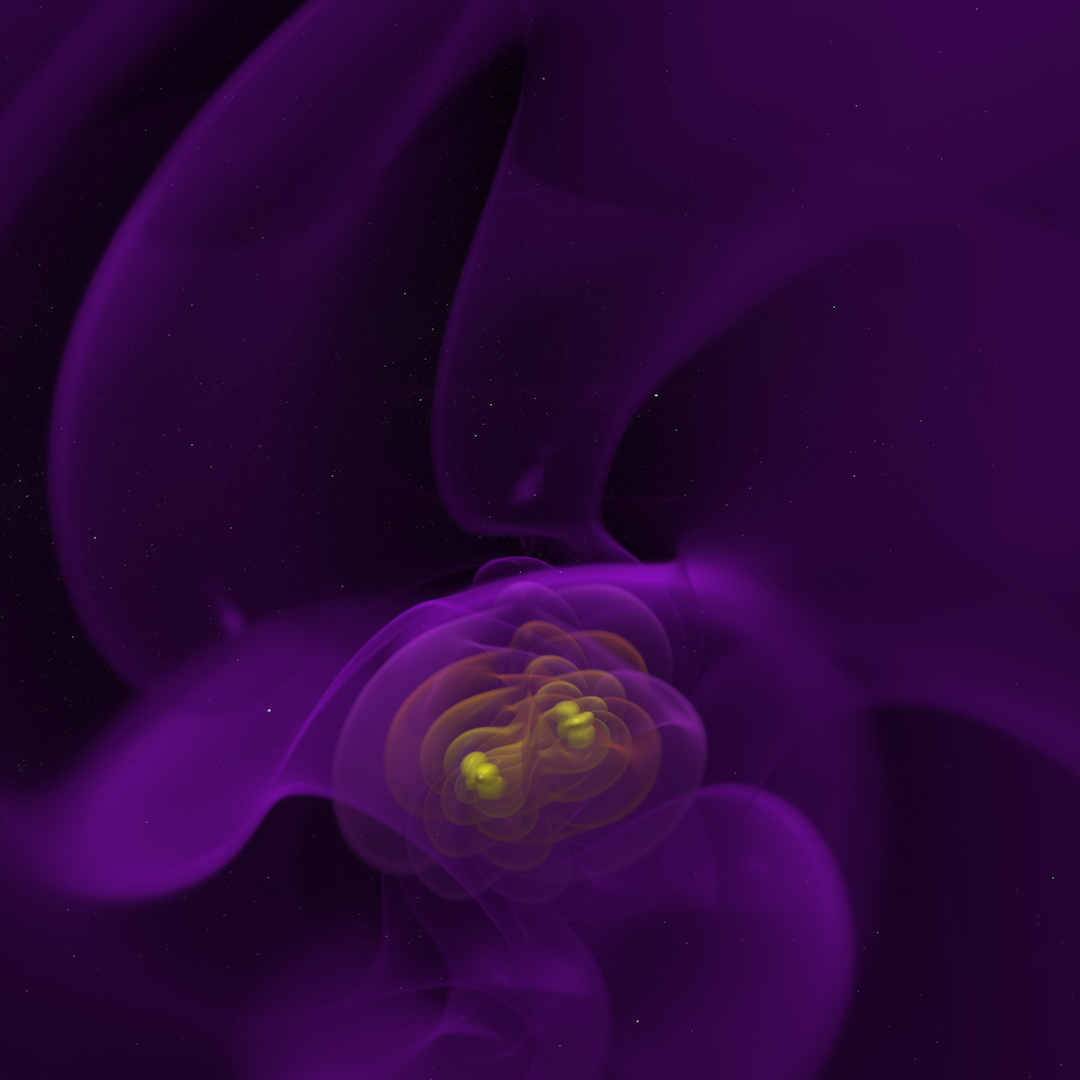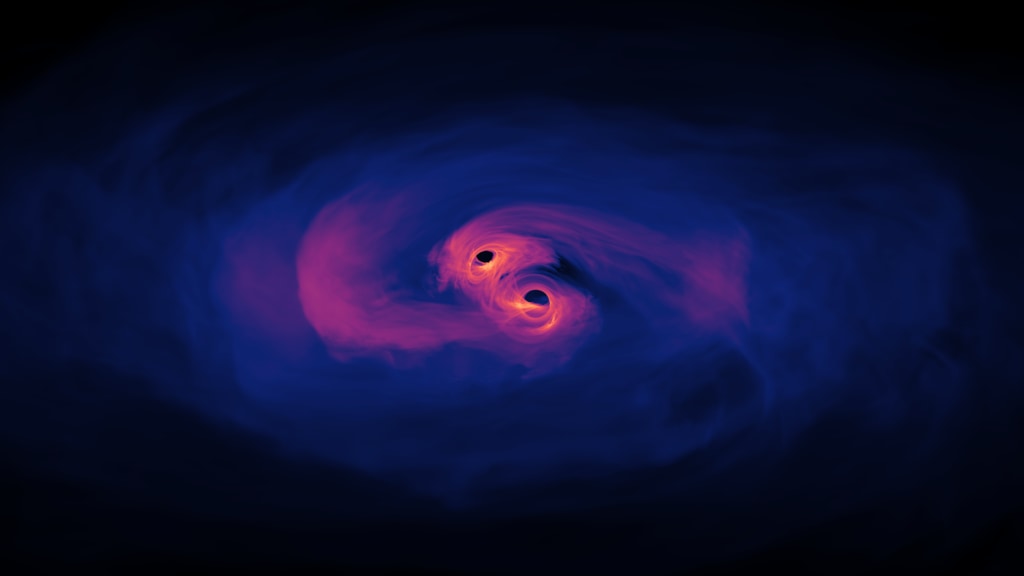Fermi Searches for Gravitational Waves From Monster Black Holes

The length of a gravitational wave, or ripple in space-time, depends on its source, as shown in this infographic. Scientists need different kinds of detectors to study as much of the spectrum as possible.
Credit: NASA's Goddard Space Flight Center Conceptual Image Lab
Our universe is a chaotic sea of ripples in space-time called gravitational waves. Astronomers think waves from orbiting pairs of supermassive black holes in distant galaxies are light-years long and have been trying to observe them for decades, and now they’re one step closer thanks to NASA’s Fermi Gamma-ray Space Telescope.
Fermi detects gamma rays, the highest-energy form of light. An international team of scientists examined over a decade of Fermi data collected from pulsars, rapidly rotating cores of stars that exploded as supernovae. They looked for slight variations in the arrival time of gamma rays from these pulsars, changes which could have been caused by the light passing through gravitational waves on the way to Earth. But they didn’t find any.
While no waves were detected, the analysis shows that, with more observations, these waves may be within Fermi’s reach.
When massive objects accelerate, they produce gravitational waves traveling at light speed. The ground-based Laser Interferometer Gravitational Wave Observatory – which first detected gravitational waves in 2015 – can sense ripples tens to hundreds of miles long from crest to crest, which roll past Earth in just fractions of a second. The upcoming space-based Laser Interferometer Space Antenna will pick up waves millions to billions of miles long.
Scientists are searching for waves that are light-years, or trillions of miles, long and take years to pass Earth. These long ripples are part of the gravitational wave background, a random sea of waves generated in part by pairs of supermassive black holes in the centers of merged galaxies across the universe.
To find them, scientists need galaxy-sized detectors called pulsar timing arrays. These arrays use specific sets of millisecond pulsars, which rotate as fast as blender blades. Millisecond pulsars sweep beams of radiation, from radio to gamma rays, past our line of sight, appearing to pulse with incredible regularity – like cosmic clocks.
As long gravitational waves pass between one of these pulsars and Earth, they delay or advance the light arrival time by billionths of a second. By looking for a specific pattern of pulse variations among pulsars of an array, scientists expect they can reveal gravitational waves rolling past them.
Radio astronomers have been using pulsar timing arrays for decades, and their observations are the most sensitive to these gravitational waves. But interstellar effects complicate the analysis of radio data. Space is speckled with stray electrons. Across light-years, their effects combine to bend the trajectory of radio waves. This alters the arrival times of pulses at different frequencies. Gamma rays don’t suffer from these complications, providing both a complementary probe and an independent confirmation of the radio results.
Within the next decade, both radio and gamma-ray astronomers expect to reach sensitivities that will allow them to pick up gravitational waves from orbiting pairs of monster black holes.

Same as above with distance units in kilometers.
Credit: NASA's Goddard Space Flight Center Conceptual Image Lab

Same as above with no text.
Credit: NASA's Goddard Space Flight Center Conceptual Image Lab

NASA’s Fermi Gamma-ray Space Telescope, illustrated here, collects gamma rays from rapidly rotating stellar remnants called pulsars. As the high-energy light travels across the Milky Way, it encounters a sea of gravitational waves, ripples in space-time, produced by pairs of supermassive black holes in the centers of merged galaxies. The waves slightly affect the arrival time of gamma rays, which Fermi should be able to detect.
Credit: Daniëlle Futselaar/MPIfR

Banner GIF from NASA feature
Black holes distort a starry background, capture light, and produce black hole silhouettes in this simulation. Each has a mass about 500,0000 times the Sun's and a distinctive feature called a photon ring outlining the black hole.
Credit: NASA’s Goddard Space Flight Center; background, ESA/Gaia/DPAC

This 2016 visualization shows gravitational waves emitted by two black holes of nearly equal mass as they spiral around each other. Orange ripples represent distortions of space-time caused by the rapidly orbiting masses. These distortions spread out and weaken, ultimately becoming gravitational waves (purple). This simulation was performed on the Pleiades supercomputer at NASA's Ames Research Center.
Credit: NASA/Bernard J. Kelly (Goddard and Univ. of Maryland Baltimore County), Chris Henze (Ames) and Tim Sandstrom (CSC Government Solutions LLC)
For More Information
Credits
Please give credit for this item to:
NASA's Goddard Space Flight Center. However, individual items should be credited as indicated above.
-
Science writer
- Jeanette Kazmierczak (University of Maryland College Park)
-
Producer
- Scott Wiessinger (KBR Wyle Services, LLC)
-
Graphic designer
- Krystofer Kim (KBR Wyle Services, LLC)
Release date
This page was originally published on Thursday, April 7, 2022.
This page was last updated on Wednesday, May 3, 2023 at 11:44 AM EDT.
Missions
This visualization is related to the following missions:Series
This visualization can be found in the following series:Papers used in this visualization
https://www.science.org/doi/10.1126/science.abm3231
https://www.science.org/doi/10.1126/science.abm3231

